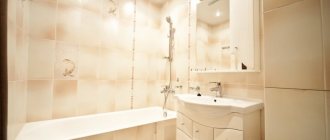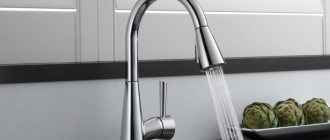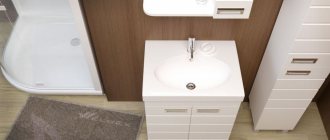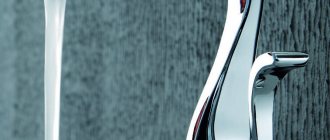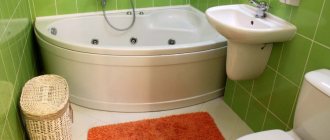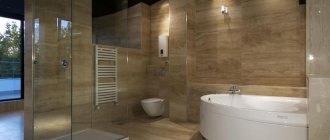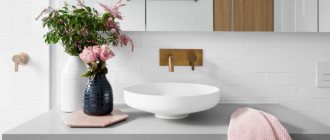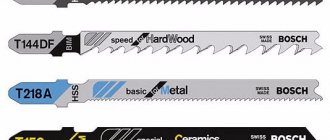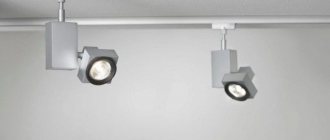An important component of comfort in the bathroom is the right light, which will highlight some interior elements and leave others in shadow. Therefore, it is recommended to plan bathroom lighting at the design stage or during a major renovation.
In this article we will tell you how to place lamps in the bathroom in order to achieve maximum comfort and coziness from the lighting in this room. No less interesting will be information about the types and features of modern lighting fixtures for the bathroom and methods of their installation. And also in this article we will consider the undeniable advantages of LED lamps over other artificial light sources.
Mistake 1. First beauty, then safety
When choosing light in the bathroom, use the principle of safety first, then everything else. No matter how beautiful the sconce is, it is not suitable for the bathroom if its protection index against moisture and dust is 0.
IP index on the packaging, photo example
Index of protection of the lamp against dust and water
The IP index consists of two numbers - IP 44. The first number (from 0 to 6) is the degree of protection against the ingress of solid particles (dust), the second (from 0 to ― protection from the ingress of liquid. The higher the number, the higher the protection. See the value on the packaging, lamp body or in the product characteristics in the online store.
protection from the ingress of liquid. The higher the number, the higher the protection. See the value on the packaging, lamp body or in the product characteristics in the online store.
The more IP a bathroom fixture has, the better.
Decoding the IP index for luminaires on the diagrams
Bathroom luminaire placement area based on IP
The choice of IP index for a lamp depends on where you install it - that is, on the location area.
- zone 0 - moisture enters directly by stream (bottom of the shower stall, bath screen, etc.);
- zone 1 - moisture often splashes (the wall of the shower stall, walls near the sides of the bathtub, etc.);
- zone 2 - moisture splashes infrequently (60 cm from the sides of the bathroom, behind the shower doors, etc.);
- zone 3 - moisture enters very rarely or never (near the ceiling, etc.).
From here it becomes clear that the sconce near the mirror should have a min IP index of 44, and the built-in lamp in the bottom of the shower should have a min IP index of 67.
Safe and unsafe zone for placing a lamp in the bathroom, taking into account the IP diagram
Moisture-proof lamps: advantages and features
Why choose a moisture-proof lamp is a logical question that arises in the user’s mind. The main reasons why moisture is the main enemy of a lamp:
- the lamps have metal parts that fail when water gets on them;
- water is a conductor of current, it can cause a short circuit not only in the lamp, but also in the wiring throughout the house;
- The glass of the lamp heats up when cold water comes into contact with it, the lamp may crack and cause harm to the user.
For these reasons, you need to choose a waterproof device. The lamps are equipped with a durable, dense shade that provides protection from water.
Advantages of moisture-proof lamps:
- no contact of water with electricity – increased safety;
- moisture-proof lamps are practically not subject to corrosion, it is almost impossible for water to get into them, which extends the life of the lamps.
The high cost of moisture-proof lighting devices is fully justified by safety.
Mistake 2. Not taking into account the furniture arrangement plan and bathroom interior
It doesn’t matter whether you select lighting in the bathroom at the renovation stage (which is best) or in a finished apartment - do it taking into account the arrangement of furniture, total area, layout and color combinations. So, it is immediately clear how much working light is needed, whether there is a risk of dark corners, etc. For example, in a light bathroom with glossy tiles and an area of 8 m2, 4-5 ceiling built-in lamps (main lighting) and two sconces on the right and to the left of the mirror (working lighting). And in a bathroom with dark tiles, an area of 4 m2 and a sink in the corner, you will need more task lighting precisely because of the non-standard layout.
Non-standard bathroom layout with a sloping wall, photo example
Standard small bathroom layout
Before buying bathroom fixtures, think about the following:
- non-standard shape and area of the bathtub;
- interior color, whether there are reflective surfaces or more matte ones;
- and how much work light, main light or decorative lighting is needed;
- personal needs (are there elderly people in the house, a mirror in the bathroom instead of a dressing table, etc.).
pros
Installing a spot device brings a number of positive aspects to equipping a room:
- compact arrangement of light fixtures;
- the light weight of the models does not weigh down the ceiling;
- the ability to locate the source in the required places;
- long-term operation of the lamp and the ability to reduce the number of replacements of used lamps;
- appliances of different shapes and colors transform the bathroom interior;
- in rooms of different sizes, lighting does not destroy the overall perception of the room;
- for high-quality work you will need a step-down transformer, an electrical network with 220 V;
- the issue of safety in the design of the lamp comes first;
- the use of LED lamps reduces energy consumption.
Small dot models visually enlarge the room. They look especially good in apartments built during the Soviet era. Here chandeliers and lampshades will only steal the space. In a room with a large area, a tandem of halogen fixtures with traditional lighting fixtures looks appropriate. Halogen spotlights for suspended ceilings in the bathroom are installed to visually increase the space (the ceiling rises, the walls move apart).
Mistake 3: Using only one light source
Usually the third error follows from the second. They installed a light in the bathroom, but didn’t think about the nuances.
Main and task lighting in the bathroom
Ceiling lighting (chandelier, lamps) provides general diffused light, which is convenient for taking a bath, but it is not suitable for shaving or applying makeup. Look at the picture below. Overhead light creates shadows on the face and highlights imperfections. Two wall lamps on the right and left or above the mirror will correct the situation (read about bathroom sconces here).
Main and task lighting in the bathroom, what is the difference?
General lighting is light that is evenly distributed over the entire area.
Working lighting - light near functional areas.
Power of bathroom fixtures: formula
The power of the lamps in the bathroom is the brightness of the illumination of the entire space. To correctly calculate the power, use the formula - type of light bulb (power consumption from the table below) * room area .
Formula for calculating the power of bathroom fixtures
*Lumen measures how much light you get from a light bulb. The more lumens, the brighter the light. The norm is 300 lumens per square. Read more about light bulbs in the following. point.
In practice it looks like this:
Bathroom area - 8m2
The power consumption of one incandescent lamp is 20 W.
8*20=160W - this is the amount of power needed to create comfortable lighting and 160 W - this is the total power for all lighting fixtures in the bathroom. That is, there are 4 of them, then 160/4 = 40 W - the power of each lighting device, if all of them have incandescent lamps.
Please note that results will vary for halogen, energy saving and LED bulbs. Use the formula we provided and you will quickly determine the necessary indicators.
IMPORTANT: The power calculation formula is suitable for bathrooms with ceiling heights below 3 meters. If the ceilings are higher, multiply the resulting power by 1.5. This is necessary because high ceilings “eat up” the light.
Example of dim lighting in a dark bathroom
An example of bright lighting in a bright bathroom
Why should you use LED lamps?
Compared to other artificial lighting sources, LED lamps deserve the highest rating. Their superiority when organizing lighting in the bathroom is in the following points:
- LED lamps are completely interchangeable with all known types of light bulbs, as they are manufactured for all types of sockets. Taking into account this fact, switching to LED lighting in a bathroom that has already undergone a major renovation will not be difficult.
- The temperature of the body of a high-quality LED light bulb does not exceed 80°C, and the body of the lamp itself with such a lamp remains cold or barely warm. As a result, overheating and subsequent yellowing of the ceiling sheet are eliminated. You don’t have to be afraid to use any type of spotlights.
- In addition to the usual standard voltage of 220 V, light sources are commercially available that are designed for a voltage of 12 V (safe for lighting rooms with high humidity).
- LED lamps can be produced without the use of glass and, unlike incandescent and halogen lamps, do not explode when switched on at high voltage.
- Based on personal taste and the color of the interior trim, you can choose LED lamps with the most suitable shade of white light.
- The high efficiency of light sources based on LEDs has made it possible to reduce the size of LED lamps and luminaires. Compact and at the same time bright lamps not only emphasize style, but also save space, which is important for small bathrooms.
Mistake 4. Not paying attention to the type of light bulbs in the lamp
There are several types of lamps: halogen, incandescent, fluorescent, LED, etc. It is the light bulbs in the lamp that determine how long they will work, how bright the lighting will be, etc.
| Lamp type/criteria | Incandescent* | Halogen** | Luminescent*** | LED**** |
| Safety | — | + | + | + |
| Electricity consumption | — | — | + | + |
| Price | from 42 rubles (+) | from 67 rubles (+) | from 350 rubles (-) | from 260 rubles (-) |
| Life time | up to 1000 hours (1.5 months) (-) | up to 2.5 thousand hours (3 months) (-) | up to 10 thousand hours (more than a year) (+) | more than 50 thousand hours (6 years) (+) |
| Brightness | — | + | + | + |
| Conclusion | + | ++ | +++ | ++++ |
* Incandescent lamps do not like humidity. Being very hot, it will burst if a few drops of water get on it. It flares up quickly, but produces a weak luminous flux. The incandescent lamp is the most power-hungry of all, but also the cheapest.
** Halogen lamps in terms of price/quality ratio are the most affordable and convenient option. They give a warm, diffused glow. They get hot, but not much. And they do not consume as much electricity as incandescent lamps.
*** The fluorescent lamp is completely safe in humid conditions. It produces a powerful luminous flux, but flares up in about 2 minutes, so it works better in combination with other types of lamps. It works silently.
**** LED lamps are the most economical of all. But due to voltage surges, they “clack”, creating unpleasant sounds. The downside is the high price.
A universal option for lighting in the bathroom is a combination of halogen and LED bulbs.
IMPORTANT : Halogen light bulbs for suspended ceilings must be covered with paint or a special coating on the reverse side. Thus, the platforms will not show through and create unsightly shadows in the stretch ceiling (see photo below).
Halogen light bulbs in the bathroom, photo example
LED light bulbs in the bathroom, photo example
TIP: Pay attention to the color of the halogen and LED lamps. Halogen ones give a warm light, while LED ones give a bright, white light.
Glow of halogen and LED light bulbs in the bathroom
Let's summarize
Lighting is usually located on the ceiling (in more rare cases on the walls), but this is far from the only placement option. The lighting on the floor of the room will look quite unusual and interesting - it is designed rather to transmit diffused, slightly dimmed light, which will allow you to relax in the bathroom after a hard day.
The bath itself can also serve as a source of light, along the perimeter of which a chain of light lights is built. This kind of lighting is intended precisely as additional lighting, which can be used for relaxation by turning off the main source.
If you have only one lamp, you won’t be able to change modes - what you have is what you have to use. Multiple lighting leaves the opportunity to choose according to the mood.
A very important area of the bathroom that needs to be illuminated especially brightly is the sink with a mirror above it. This is where we perform a lot of hygiene procedures, and we need to see our face clearly.
The lighting can be installed on the sides of the mirror, under it or above it. There are models of mirrors with already built-in lighting, and for ordinary ones you can purchase a separate lamp.
When choosing a lamp, pay attention to protecting its body from moisture: splashes can fall on the lamp at any time, especially when it is placed directly next to the sink and bathtub.
Often, instead of a mirror, an entire wall cabinet is purchased at once: the mirror doors, in which you can see your reflection, dissolve, and everything you need for washing, as well as cosmetic supplies, is stored inside. This “combined” option is quite convenient: it saves space, and the necessary items are always at hand.
Sometimes the shelves are located not inside the mirror, but on the side of it.
Most companies have thought out the issue of lighting this kind of items very well: LEDs are installed in the cabinet, directly on top, or along the perimeter of the shelves, providing an even light that does not hit the eyes.
If the bathroom cabinets are located separately, then you will have to think through the lighting for the shelves yourself. And it seems to me that it is necessary here. Often it is in such cabinets that huge reserves of all kinds of funds are stored, and no one wants to delve into the dark depths.
In addition to classic spot lighting, there are more elegant options - for example, transparent balls hanging from the ceiling give the room volume and look very gentle. But to install them you need fairly high ceilings, which not every home has.
The English style, which we wrote about earlier, goes even further and suggests hanging a luxurious crystal chandelier in the bathroom and placing sconces in the same style on the walls. The idea is quite controversial from a practical point of view, but it looks very nice.
Photos: homebuilding.co.uk, www.pinterest.com, happymodern.ru, ihouzz.ru, meekfamily.net, lwww.thayray.com.
Mistake 5. Choosing bathroom fixtures without taking into account the height and type of ceiling
Recessed ceiling lights for small bathrooms
Such lamps are distinguished by the fact that almost their entire body is located under a suspended or suspended ceiling. Only a decorative trim peeks out from the outside. They look minimalistic and do not press on top, so they are suitable for small bathrooms with low ceilings.
Recessed ceiling lights for small bathrooms
Recessed ceiling lights in the bathroom interior
Surface-mounted lights for medium-sized bathrooms
The overhead model is not built into the ceiling, so it takes up more height than built-in models. But despite this, there are also compact overhead lamps that will fit a standard ceiling and will not take up much space.
Surface-mounted lights for medium-sized bathrooms
Overhead lamps in the bathroom interior
Wall lights for functional areas
For example, wall spotlights above a mirror create accent task lighting. Here, too, it is better to adhere to the principle: small bath - compact lamps, and vice versa.
Wall lamp above the mirror in the bathroom
Wall sconces to the right and left of the mirror in the bathroom
Bathroom lighting fixtures must be protected from moisture. This is the main selection criterion; in addition, the type of lamp, its power and color temperature are important.
The number of appliances depends on the size of the bathroom. For a small room, a ceiling lamp and lighting near the mirror will suffice. In a spacious room you can place four or five types of devices.
Set of lamps
ics for a large bathroom could be, for example, like this:
- ceiling: spotlights plus LED strip around the perimeter;
- walls: sconces on both sides of the washbasin;
- furniture: mirrored cabinet with lighting, shelves with LED strip along the bottom edge, miniature lamps with motion sensors inside the cabinets.
The most important point: all lamps must be protected from water vapor, condensation and splashes. Those located on the floor also protect against possible flooding.
Water protection
| The packaging of each lamp must bear the international IP marking. IP is an abbreviation for Ingress Protection, “protection from the outside.” Indicates the level of protection of the device from external influences. The first number after the letters IP indicates how the lamp tolerates exposure to dust, the second - moisture. The higher the numbers, the better the dust and moisture protection. In addition to the letters I and P, you can also find other Latin letters on the packages. They indicate the degree of protection against contact. For example, A means that the device is safe to touch with the back of your hand, B means it is safe to touch with your finger. This information is relevant only for open structures, that is, for lamps that are not covered with shades. |
IP protection classes
| Example. IP68 protection class means that the lamp is not afraid of either dust or water. It can be installed, say, on the ceiling above an open shower stall. Safety requirements for luminaires in different zones.
|
|
Illumination
| The illumination standard for the bathroom (it is prescribed in SNiPs) is 50 Lux. Illumination is measured in lux. 1 lux is 1 lumen per 1 sq.m. Lumen is a luminous flux, this value is indicated on each light bulb. |
| Example. Let's calculate how many light bulbs will be needed to illuminate a bathroom measuring 9 sq.m. We multiply the norm according to SNiP by the area of the room - 50x9, we get 450 Lm. 80-90% of this flow should come from general, ceiling lighting. You can choose, for example, two LED ceiling lights of 2-3 W (about 250 Lm each). For the bathroom, we recommend using two types of light bulbs, LED and halogen. Important: only LEDs can be used for suspended ceilings. The power of halogen lamps in the bathroom should not exceed 35 W and the voltage should not exceed 12 V. |
| |
Approximate ratio of power and luminous flux of lamps
Halogen bulbs themselves are cheaper than LED bulbs, but LEDs are more reliable and more economical to use. For comparison: the working life of a halogen lamp is up to 2000 hours, and an LED lamp is up to 25,000 hours.
Comparison of halogen and LED lamps |
| Advice. When installing a halogen light bulb, hold it with a cloth or gloves. Afterwards, the flask must be thoroughly wiped with a cloth and alcohol. It is important to use a fabric that does not leave lint on the surface, such as microfiber. |
Colorful temperature
Lamps can produce warm, neutral or white light. It is perceived differently: for example, warm light creates comfort, cold light helps to concentrate.
In the area where the bath is installed, we recommend using warm light, it helps to relax. For other areas, lighting of a neutral shade is suitable. Cool white light is also acceptable for illuminating the shower stall.
| Color temperature is measured in Kelvin: |
By the way, you can buy light bulbs that can change color temperature. Such devices are controlled using a remote control or a regular wall switch: the temperature changes every time the key is turned on.
Address tape in the bathroom interior | For illumination, you can use not only white, but also single-color (for example, blue or green), regular or addressable RGB LED strip. Plain and multi-colored tape is used to illuminate the ceiling, shelves and niches. The RGB tape can change color; using the remote control you can choose any shade, be it soft pink or bright purple, or set the color change. Address tape is most often used to illuminate the ceiling; it can be used to create complex color transitions. |
The influence of layout and design on the choice of lamp
The choice of lamps is influenced by at least six factors:
|
For a bathroom with high ceilings, a chandelier or pendant in the center of the ceiling is suitable. For rooms with low ceilings, it is better to use built-in or overhead spots.
Consider the height at which the ceiling lights will be located. The lower they hang, the brighter and more focused light they produce.
Dark surfaces absorb light, light surfaces reflect. A bathroom with walls covered in dark gray matte tiles requires more powerful fixtures than a room with a white glossy finish.
The design of lighting fixtures should either be as neutral as possible or match the overall style of the bathroom.
| Lamps for different interiors styles |
Lighting levels
Ideally, lighting should be three-level:
|
| The following may be responsible for general lighting:
If you have a suspended ceiling, you can install a “star scattering”. These are many LED dots that are installed under the canvas, creating the effect of a sky strewn with stars. |
| The work area is a washbasin and a mirror next to it. The lighting should be bright and at the same time diffused. Use sconces, LED strip, rotating spotlights or wall-ceiling lamps. The mirror needs to be illuminated symmetrically. It is important that the reflection is as natural as possible, without unnecessary shadows. The best option is lamps on the sides or around the perimeter of the mirror. Do not place lamps below face level. You can also choose a mirror or mirror cabinet with built-in lighting. There are heated models - condensation does not form on them. |
|
| Decorative lighting creates an atmosphere and helps set accents. Used to decorate pedestals, niches, steps, shelves and other elements. You can highlight everything, from the internal shelves of cabinets to the washbasin. |
General tips and life hacks
- Lamps in different functional areas should be routed to different keys of the same switch or to separate switches.
- Lamps located opposite the mirror provide almost twice as much light.
- You cannot install sconces above the bathtub - it is unsafe.
- In rooms with glossy tiles/mosaics, light should not be directed perpendicular to reflective surfaces, otherwise unnecessary glare will result.
- Lighting with a motion sensor, mounted inside cabinets, gives +100 to comfort.
- Floor lamps can visually expand the room. For floors, choose devices with a degree of protection IP67 or higher.
The Leroy Merlin team will help you select all the necessary materials - welcome to the Lighting section. On the site you can be inspired by ready-made bathroom interior solutions.
Mistake 7. Buy a chandelier/sconce with a dark shade and pattern
The material of the lampshade or floral shades can eat up the light power and convey the color of the light incorrectly. For example, a lampshade made of dark, light-retaining material reduces the level of illumination, which is most inconvenient in the bathroom, while many decorative details leave a shadow. Therefore, check immediately in the store how overly designer and decorative models transmit light.
Unsuccessful sconce for the bathroom, photo example
A successful example of a sconce for a bathroom, photo example
Do you need ceiling lighting?
Overhead lighting may consist of one or more fixtures. In a small room you can install one lighting device in the shape of a plate, and for a large room a chandelier and several lamps are suitable.
When choosing lighting equipment, consider the material of the ceiling covering. Suspended chandeliers are suitable for concrete bases, and built-in models are suitable for plasterboard and PVC ceilings.
A spotlight that emits directional light is suitable for the bathroom. It makes it possible to adjust the direction of the light flow.
A crystal chandelier framed by a diode strip will look luxurious. You can also install one lamp in the middle of the ceiling, and use spotlights to highlight the hotel areas. If the room is small, then place built-in fixtures around the perimeter to get even lighting and visually make the ceiling higher.
Mistake 8. Not paying attention to the material of the lamp
Even the most fashionable metal sconce without a protective layer will eventually become covered with red spots. And models made of glass and plastic will last much longer. Such materials are not destroyed by moisture and detergents, and in the long run save time and money. If you still cannot do without metal materials, check the composition for the presence of a reliable powder coating (protective layer).
Unsuitable material for bathroom fixtures
Suitable material for bathroom fixtures
Types of lamps
Halogen – suitable for low-mounted recessed luminaires.
Halogen Philips H7
These lamps save energy. Their service life is 3-5 times longer than that of conventional ones.
It is not recommended to install in lamps without protective glass.
LED lamps have an aesthetic appearance and a strict design. These lamps are compact and have low energy consumption. Suitable for miniature models. Its service life is 10 times longer than that of conventional lamps.
LED bulbs
Mistake 9. Confusing decorative and main lighting
A sconce with a colored lampshade and an LED strip on a plasterboard ceiling will not replace the main lighting. The light from a colored sconce near the mirror will distort the reflection, and the LED strip will only create a relaxing atmosphere. Therefore, divide all lighting into three groups: basic (chandelier, ceiling lamps) to wash the floor, task (wall lamps near the mirror) to apply makeup and decorative (LED strip on the steps or ceiling) to leisurely take a bath.
Decorative lighting in the bathroom
Decorative lighting in the bathroom
Basic lighting in the bathroom
Main lighting in a spacious bathroom
Laying electrical wiring on the ceiling
The correct location of light sources depends on the correct installation of electrical wiring. It is necessary to ensure that every corner of the room is equipped. Therefore, the placement of the cable is planned especially carefully. Rational placement of the cable will help save costs on its purchase.
It is recommended to mark the diagram on the ceiling with a marker. For protection, the electrical cable is placed in a corrugated pipe and then fixed to the ceiling. A copper cable with a cross-section of 1.5 mm2 monocore is purchased; the cable for sockets in the bathroom is laid with a cross-section of 2.5 mm2. The cable is run from the common distribution box of the apartment, which is located in the corridor.
It is recommended to connect lamps in groups of 2-3 pieces. This will allow you to turn on the lights in the room by zone, for example, above the shower stall, rather than in the entire bathroom. The fan is connected to one of the groups.
Cabling
On the ceiling, a grinder with a diamond-coated disk is used for scoring. The electric cable is placed in grooves, and a solution of cement and sand is covered on top. Starting and finishing putty levels the surface of the ceiling.
Suspended ceiling
Without gating, the cable is secured to the ceiling with staples. The cores are insulated before connecting the lamps.
Bathroom lamp layouts: real examples
Lamps in a dark bathroom with an area of 4 m2 and ceilings of 2.9 m
Project by designer Yulia Chernova
General lighting : 4 built-in spotlights - 2 above the sink, 1 above the bath, 1 above the toilet.
Working lighting : LED lighting around the perimeter of the mirror.
Layout of four lamps in the bathroom, real photo example
Lamps in a bright bathroom with an area of 6.5 m2 and ceilings of 2.9 m
Project "Côte d'Azur", CO:interior
General lighting: 6 spot built-in ceiling lights - 2 of them are accent lighting above the bathtub, 2 above the shelf in the niche, 2 on the sides of the bathroom so that there are no dark corners.
Working Light:
2 accent sconces above the mirror, 2 spotlights on top in the shower stall.
Layout of ten lamps in the bathroom, real example
Layout of ten lamps in the bathroom, real photo example 2
Rotary and non-rotating
Point - rotating and non-rotating types solve the problems of small rooms; they do not eat up space, but on the contrary, expand it. According to their characteristics, they have the following differences:
- Rotary. They have the ability to change the direction of the light beam. The direction is changed manually with a simple movement of the hand. Thanks to the adjustment, fewer lamps can be placed in the room than with rotating models.
- Fixed. They have a rigid fastening. A ray of light illuminates a specific area of space. by zone or the entire room as a whole.
One of the most popular rotating devices are spot models of lighting fixtures
Variety of rotary models
Spotlight with rotating mechanism
Illumination of mirrors, washbasin, other elements
The lighting of the mirror should be natural so that it does not distort the reflection. It is better to install the lamp above it, on the sides, or combine these 2 options. Choose lighting fixtures with white shades with a matte finish that emit soft light.
The LED strip can be installed under the sink or along the edges of the bathtub. Plates with diodes are used to illuminate niches, drawers with clothes, cabinets, or along the perimeter of the wall.
In the bathroom or shower, lamps help create a relaxing atmosphere. Several devices can be installed above the bathtub or in the shower stall.
It is not recommended to install the lamp under a mirror, otherwise the display will be distorted. For the same reason, you should not use colored light bulbs or lampshades.
Number of lamps
The number of light bulbs is chosen depending on their power and the area of the room.
The number of light bulbs and their power in the bathroom directly depends on the area of the room.
- Up to 5 sq.m. – from 60 to 150 W.
- 5 to 10 sq.m – power varies between 80 and 250 W.
- 10 to 15 sq.m – lighting at 100-400 W.
- 15 to 20 sq.m – minimum power – 200 W, maximum – 500 W.
- 20 to 30 sq.m – light brightness is set at 240-700 W.
The minimum value corresponds to soft light, and the maximum value corresponds to very bright light. However, general lighting is not enough; you need to take care of functional lighting. We are talking about areas around the mirror, washbasin and bathroom.
It is also recommended to consider the option of a decorative light source in the form of a garland or an atmospheric lamp.
